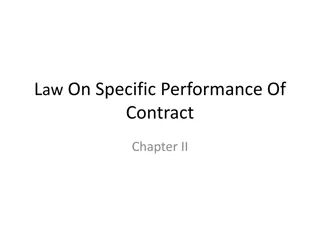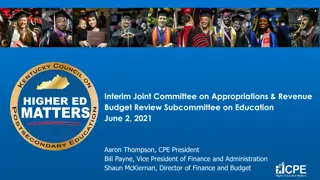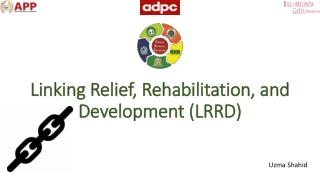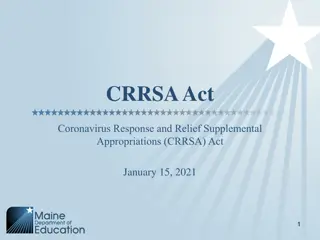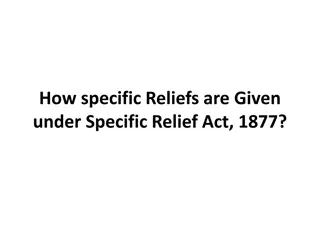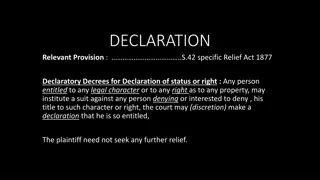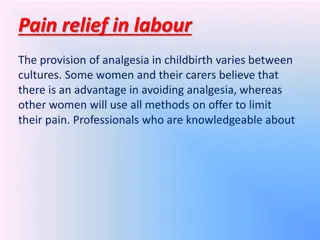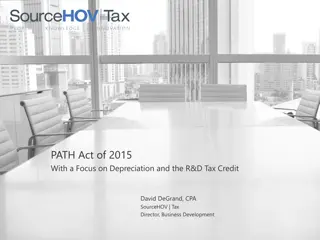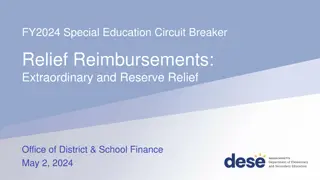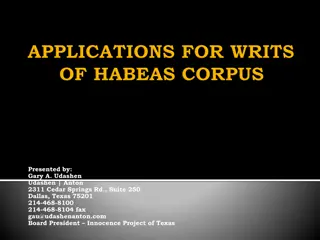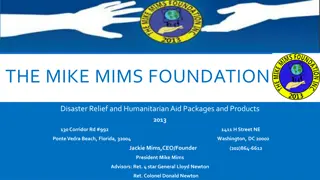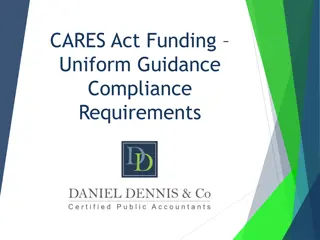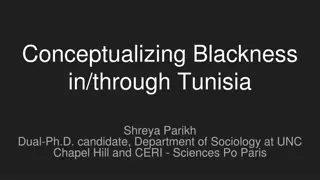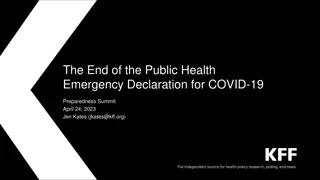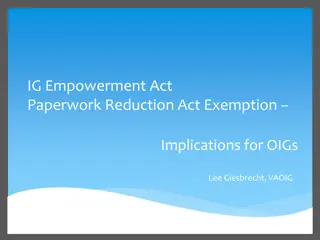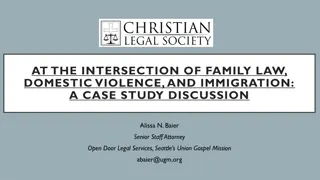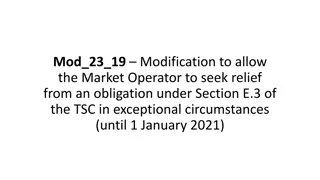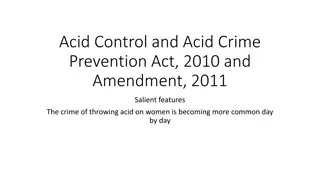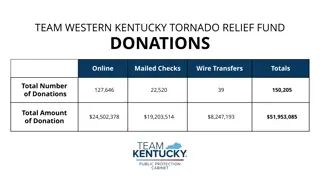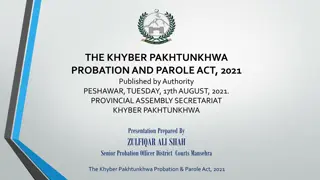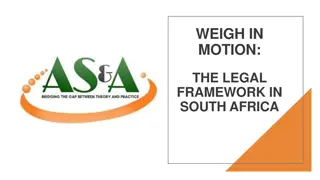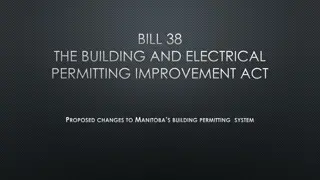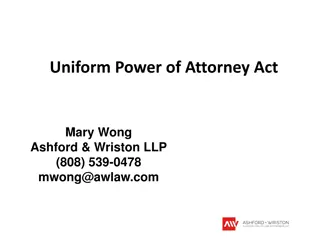Overview of Specific Relief Act 1962 by Shreya Gopi
Specific Relief Act 1962, categorized into defining remedies, ensures relief for breach of contract or withdrawal from promise. Enacted in 1963, it provides remedies under Indian Contracts Act. Part II covers property recovery, contract performance, instrument rectification, rescission, cancellation, and declaratory decrees. Chapter 1 allows property possession recovery, while Chapter 2 addresses specific contract performance aspects.
Download Presentation

Please find below an Image/Link to download the presentation.
The content on the website is provided AS IS for your information and personal use only. It may not be sold, licensed, or shared on other websites without obtaining consent from the author. Download presentation by click this link. If you encounter any issues during the download, it is possible that the publisher has removed the file from their server.
E N D
Presentation Transcript
SPECIFIC RELIEF ACT-1962 BY SHREYA GOPI
THIS LAW DIVIDE INTO THREE MAIN CATEGORY 1. Those which define a right 2. Those which define a remedies 3. Those which define a procedure And SPECIFIC RELIEF ACT belongs to second category. It is a law deals with remedies. The term relief is only another word for remedy which a court is allowed allowed by a law to grant to suitors
HISTORY OF THE ACT This Act was enacted in 1963 following the approach that when a person has withdrawn himself from the performance of a particular promise or a contract with respect to another person, the other person so aggrieved is entitled to a relief under Specific Relief Act, 1963. This Act is considered to be in one of the branches of the Indian Contracts Act, 1872.
THE GENESIS OF SPECIFIC RELIEF ACT -1962 INDIAN CONTRACT ACT DAMAGE BREACH OF CONTRACT SPECIFIC RELIEF ACT SPECIFIC RELIEF
PART 2 Part II Specific Relief Act This part contains six chapters. Chapter I : : Recovering Possession of Property. Chapter II : Specific Performance of Contracts. Chapter III : : Rectification of Instruments. Chapter IV : : Rescission of Contracts. Chapter V : : Cancellation of Instrument. Chapter VI : : Declaratory Decrees.
CHAPTER 1 RECOVERY OF POSSESSION OF PROPERTY RECOVERY OF SPRCIFIC PROPERTY Under this chapter the person can recover the movable and immovable property according to the procedure which Is prescribed in CPC 1908 Suit for possession of immovable must be filed within 6 months from the dispossession Such suit cannot be filed against government. (section-6) Any person in a possession of movable property of which he is not owner may be compelled specifically to delivery it to person entitled in following case 1. if he is a agent or trustee of plaintiff. 2. when compensation in money would not afford the plaintiff adequate relief for the loss of the things claimed. 3. when it would be extremely difficult to ascertain the actual damage caused by its loss. 4. when the possession of the thing claimed has been wrongfully transferred from the plaintiff.
CHAPTER 2 SPECIFIC PERFOAMANCE OF CONTRACT This chapter can be divided into 4 parts 1. CONTRACT WHICH CAN BE SPECIFICALLY ENFORECED. 2. CONTRACTS WHICH CANNOT BE SPECIFICALLY ENFORECED. 3. PERSONS FOR AGAINST WHOM CONTRACTS MAY BE SPECIFICALLY ENFORECED 4. DISCREATION AND POWERS OF COURT.
CONTRACTS WHICH CAN BE SPECIFICALLY ENFORCED CONTRACTS WHICH CANNOT BE SPECIFICALLY ENFORCED 1. 2. 3. WHERE NO OTHER SUITABLE REMEDY VALID CONTRACT IN EXISTENCE CONTRACT NOT EXTINGUISHED BY DECREE AGREEMENT FOR RECONVEYANCE OR REPURCHASE DELAY SALE BY JOINT OWNER 1. Where compensation is adequate 2. Contracts involving personal skills 3. Contracts detrimental in nature 4. Contract requiring constant supervision 5. Construction contract 4. 5. 6.
Person against whom contract may be specifically enforced Specific performance of a contract cannot be enforced in favour of a person 1. Any party of the contract 2. The representative-in-interest 3. Settlement on marriage 4. Tenant of life 5. A reversioner in possession 6. Company which arises out of amalgamation 7. Promoters of company 1. Who would not be entitled to recover compensation for its breach. 2. Incapable of per foaming a contract 3. Who violates any essential terms of contract 4. Who acts in a fraud of the contract 5. Wilfully acts at variance with or in subversion of contract.
DISCRETION AND POWERS OF COURT The discretion to be used not arbitrary but sound and reasonable guided by judicial principles The following are cases in which the court may properly exercise discretion not to specific performance Unfair advantage Hardship Inequitable to enforce Substantial performance by one side Mutuality of remedy
POWER OF COURT TO AWARD COMPENSATION In a suit plaintiff may also claim compensation as additional or substantial relief . Court can grant compensation either in case where specific performance is granted or rejected. Such compensation could only be granted if it is claimed by plaintiff in a suit. Even if the contract is incapable of specific performance the court could grant a compensation.
RELIEF CAN BE GIVEN BY THIS WAY UNDER THIS ACT 1. Rectification of instrument 2. Rescission of instrument 3. Cancellation of instrument 4. Declaratory instrument 5. Preventive relief 6. Injunction (PART -3)
RECTIFICATION OF INSTRUMENT If the parties after an agreement changed their minds and it is their changed intension that is embodied in the instrument, there is no ground for rectification. What is done on a purpose, is obviosity not done by a mistake. ESSENTIALS TO BE PROVED .. THAT THERE WAS A MUTUAL MISTAKE OR FRAUD THAT THE INSTRUMENT ON THAT ACCOUNT DID NOT TRULY EXPRESS THE INTENSION OF THE PATIES
WHEN RESCISSION AVAILABLE Where contract is voidable or terminable by plaintiff. Where the contract is unlawful for causes not apparent on his face and the defendant is more to blame. LOSS OF RIGHT OF RESCISSION Affirmation Where restitution not possible Intervention by third parties
CHAPTER 5 CHAPTER 6 DECLARATORY DECRESS CANCELLATION OF DOCUMENT SECTION 31 TO 33 OF THE ACT talks about cancellation of document cancellation can be ordered By any person against whom written statement is voidable And who has reasonable apprehension If it left outstanding may cause serious injury So that person can be sue and get adjudged And it is discretion of the court SECTION 34 AND 35 OF THE ACT DEALS WITH THIS ANY PERSON Entitled to any legal character or right As to any person May institute a suit By any person denying his title or right Court in its discretion make such declaration Such declaration binding only on parties
PART 3 PREVENTIVE RELIEF According to JOYCE An order remedial, the general purpose of which is to restrain the commission or continues of some wrongful act of the party informed. Injunction act in person am. It does not run with the property. There are three characteristics It is a judicial process The relief obtained thereby is a restraint or prevention. & The act prevented or restrained is wrongful. KINDS OF INJUCTION TEMPORARY INJUCTION for specific period PERPETUAL INJUCTION at the end of the suit
LANDMARK JUDGEMENT Geeta Rani Paul v. Dibyendu Kundu It was held by the Hon ble Supreme Court that when the plaintiff files suit regarding the dispossession, it is enough if he proves that he is entitled over the title of that property. Once the title is proved other details like being divested from the property or other things are not required to be proved. N.P. Thirugnanam v.Dr. R.J. Mohan Rao It is held by the Court that when in a case it is observed that the plaintiff itself did not perform his portion in the contract or neither does he want to perform, so the decision regarding specific performance act will be issued under this favor. Prem Singh vs. Birbal The Court, in this case, held that when a contract is valid no doubt of it being cancelled arises and when it is void ab initio (meaning no existence in the law from the starting ) then no also no option of cancelling it arises as it is not present in the eyes of law. When a contract has no existence no action is enforced on it.
CONCLUSION This legal statute s main aim is that no person shall live with the damages and losses and those who have caused such a situation must be in a position to restore all unlawful benefits received by them. The Specific Relief Act, 1963 has a set of reliefs given to the parties to suit. They have different reliefs and enforcing rules which focus on providing enough compensation to all.




